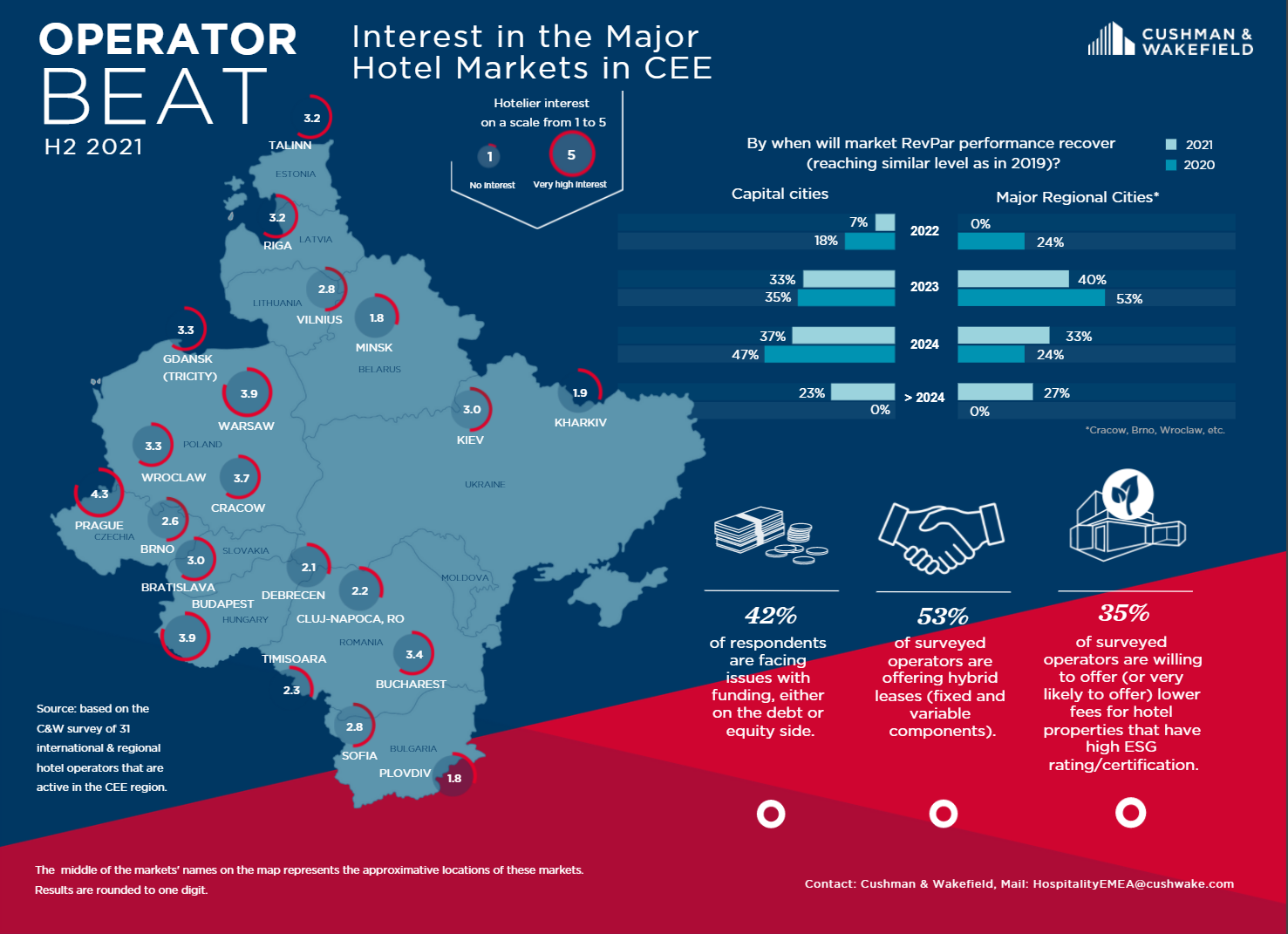The Bucharest hotel market is beginning to recover; operators wishing to extend their networks in the city
Bucharest hotel market has the strongest growth among CEE capitals in terms of revenue per available room (RevPAR), mainly driven by occupancy, over the past year due to the lifting/easing of restrictions related to travel and rescheduled event from 2020 to 2021 (i.e. European Football Championship, concerts and other sporting events). Market dynamics keep attracting the attention of hotel operators to expand their networks.
Cushman & Wakefield, one of the world’s leading real estate services companies, presents its Hotel Operator Beat H2 2021, a survey of leading international hotel operators active or interested in the CEE region, including the performance of the Romanian hotel market. The survey investigated hotel operators’ preferences, plans and developments, as well as their views on the impact of COVID-19 and market recovery expectations.
The survey, conducted in the fourth quarter of 2021, was completed by senior executives representing more than 30 operators already present or interested in entering the CEE region. Operators surveyed represent over 730 hotels with over 121,000 rooms already in operation in the CEE region, with an additional 590 proposed hotels comprising over 50,000 rooms in the pipeline.
In the CEE region, Prague, Warsaw, Budapest and Bucharest are the 20 most interesting cities. Compared to 2020, operators have generally shifted their interest to prime locations, especially those with a high barrier to entry at place of secondary or tertiary markets.
Bucharest was indicated as a high or very attractive market for 58% of the operators surveyed. It should be mentioned that the players who left the market were very interested in returning to Bucharest. Only a small proportion of operators have not targeted the capital as the main objective of their expansion, as their strategy is more oriented towards holiday resorts or Central and Western Europe.
The Romanian capital reached an average occupancy rate of 32.1% in 2021. This reveals a growth of 77.7% compared to the same period in 2020, the highest increase among the capitals of the CEECs ( i.e. Bratislava, Bucharest, Budapest, Prague, Sofia and Warsaw). ). The strong occupancy growth is the result of the easing of travel restrictions and the rescheduled event from 2020 to 2021 (i.e. European Football Championship, concerts and other sporting events ).

Moreover, supported by the occupancy rate, Bucharest’s RevPAR increased by 67.3% in 2021 compared to 2020, revealing the strongest RevPAR growth among CEE capitals. However, overall, the Bucharest hotel market reached a RevPAR of EUR 20.5 (negatively impacted by the drop in ADR) considered the third highest among CEE capitals. This is reflected as hoteliers approach a volume strategy during the recovery period, reasoning the slight ADR discount.
STR reveals that the ADR in euros of the Romanian capital is down by 5.9% in 2021 compared to 2020. This trend is the result of the updated ADR from January 2021 to May 2021, with a focus on volume growth. The ADR began to increase massively from June 2021 when travel restrictions began to ease and rescheduled events began.
It is important to highlight that once travel restrictions eased in 2021, although the market was still dominated by domestic demand, international overnight stays started to grow at a faster rate than the domestic market. Additionally, zooming in on the nationality mix of overnight stays in paid accommodation in 2021, Oxford Economics recorded a similar mix to 2019. Thus, the facts mentioned above along with the postponement of several hotel developments highlight the expectation that Bucharest will witness a sustained and rapid recovery in demand.
Half of the respondents expressed interest in Cluj-Napoca, one of the fastest growing secondary cities in Romania. Nevertheless, the growing attractiveness of the city is attracting the interest of major hotel chains. The majority of these respondents are internationally renowned brands, several of which are not yet present on this market or in Romania. Although, according to STR, the market is currently dominated by independent hotels (approx. 77.9% of current room supply), the pipeline foresees two additional hotels representing approx. 270 rooms under the Radisson Blu and Courtyard by Marriott brands.
Other cities in Romania mentioned by surveyed operators as target markets (in addition to those directly listed in the survey) include Iasi, Constanta and Brasov. It is important to point out that Brasov is becoming quite a dynamic hotel market, highlighted by the continuously growing pipeline that awaits a c. 660 branded rooms (by international and local chains) by 2023, and recent transactions recorded (i.e. the two Rina hotels negotiated in 2021 for around 4.3 million euros). Additionally, by the end of 2022, Constanta will represent a c. Hotel with 100 rooms under the Crown Plaza by IHG Hotels brand.
Finally, the majority of operators surveyed expect all CEE markets to recover by 2024, although leisure destinations and regional cities are expected to reach 2019 performance levels sooner than capital cities. . This could be explained by the expected early rebound in leisure and domestic businesses.
David Nath, Head of Hospitality, CEE and SEE Cushman & Wakefield: “Bucharest is becoming a very dynamic market within the CEE region, which can be seen through the good performance recorded during the pre-covid period as well as the recovery period, the liquidity visible in the trading scene (i.e. in 2021, 4 hotels sold for c. EUR 19.2) and varied pipeline to come. Additionally, our team has currently completed a trader selection process for one of the most intriguing players in the market (held confidential for the time being). We were delighted to see the great interest of international hotel chains for the Romanian capital. In addition, we have seen a fairly growing enthusiasm to enter the market from operators who are not yet present, but they believe in the potential of this city.



Comments are closed.